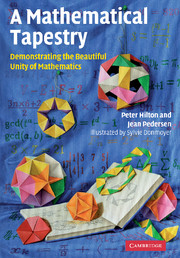Book contents
- Frontmatter
- Contents
- Preface
- Acknowledgments
- 1 Flexagons – A beginning thread
- 2 Another thread – 1-period paper-folding
- 3 More paper-folding threads – 2-period paper-folding
- 4 A number-theory thread – Folding numbers, a number trick, and some tidbits
- 5 The polyhedron thread – Building some polyhedra and defining a regular polyhedron
- 6 Constructing dipyramids and rotating rings from straight strips of triangles
- 7 Continuing the paper-folding and number-theory threads
- 8 A geometry and algebra thread – Constructing, and using, Jennifer's puzzle
- 9 A polyhedral geometry thread – Constructing braided Platonic solids and other woven polyhedra
- 10 Combinatorial and symmetry threads
- 11 Some golden threads – Constructing more dodecahedra
- 12 More combinatorial threads – Collapsoids
- 13 Group theory – The faces of the trihexaflexagon
- 14 Combinatorial and group-theoretical threads – Extended face planes of the Platonic solids
- 15 A historical thread – Involving the Euler characteristic, Descartes' total angular defect, and Pólya's dream
- 16 Tying some loose ends together – Symmetry, group theory, homologues, and the Pólya enumeration theorem
- 17 Returning to the number-theory thread – Generalized quasi-order and coach theorems
- References
- Index
12 - More combinatorial threads – Collapsoids
Published online by Cambridge University Press: 10 November 2010
- Frontmatter
- Contents
- Preface
- Acknowledgments
- 1 Flexagons – A beginning thread
- 2 Another thread – 1-period paper-folding
- 3 More paper-folding threads – 2-period paper-folding
- 4 A number-theory thread – Folding numbers, a number trick, and some tidbits
- 5 The polyhedron thread – Building some polyhedra and defining a regular polyhedron
- 6 Constructing dipyramids and rotating rings from straight strips of triangles
- 7 Continuing the paper-folding and number-theory threads
- 8 A geometry and algebra thread – Constructing, and using, Jennifer's puzzle
- 9 A polyhedral geometry thread – Constructing braided Platonic solids and other woven polyhedra
- 10 Combinatorial and symmetry threads
- 11 Some golden threads – Constructing more dodecahedra
- 12 More combinatorial threads – Collapsoids
- 13 Group theory – The faces of the trihexaflexagon
- 14 Combinatorial and group-theoretical threads – Extended face planes of the Platonic solids
- 15 A historical thread – Involving the Euler characteristic, Descartes' total angular defect, and Pólya's dream
- 16 Tying some loose ends together – Symmetry, group theory, homologues, and the Pólya enumeration theorem
- 17 Returning to the number-theory thread – Generalized quasi-order and coach theorems
- References
- Index
Summary
What is a collapsoid?
There is an interesting class of polyhedra having the property that all faces are congruent parallelograms. Since all faces are parallelograms, the polyhedra in this class have the property that every edge determines a zone of faces such that each face in the zone has two sides parallel to the given edge. Polyhedra having this latter property are called zonohedra; we may speak of an n-zonohedron to emphasize that the polyhedron in question has n zones. As interesting examples of polyhedra in this class, the rhombic dodecahedron (which has 12 faces and 4 zones) and the rhombic triacontahedron (which has 30 faces and 6 zones) appear in Figure 12.1, which is based on illustrations by H. S. M. Coxeter (1907–2003).
In [8], Coxeter describes the general theory of zonohedra and states that the angles on the faces of the rhombic dodecahedron are 70°32′ and 109°28′, while the angles on the faces of the rhombic triacontahedron are 63°26′ and 116°34′. You will readily believe that these angles are not ones that we get easily by folding paper (though we could get them in principle!). However, these are beautiful models and we can construct polyhedra like them by replacing each of the rhombic faces with a 4-faced pyramid without its base, which is composed of 4 equilateral triangles. We call this a cell and refer to each of the triangles as a triangular face of the cell.
- Type
- Chapter
- Information
- A Mathematical TapestryDemonstrating the Beautiful Unity of Mathematics, pp. 175 - 194Publisher: Cambridge University PressPrint publication year: 2010



